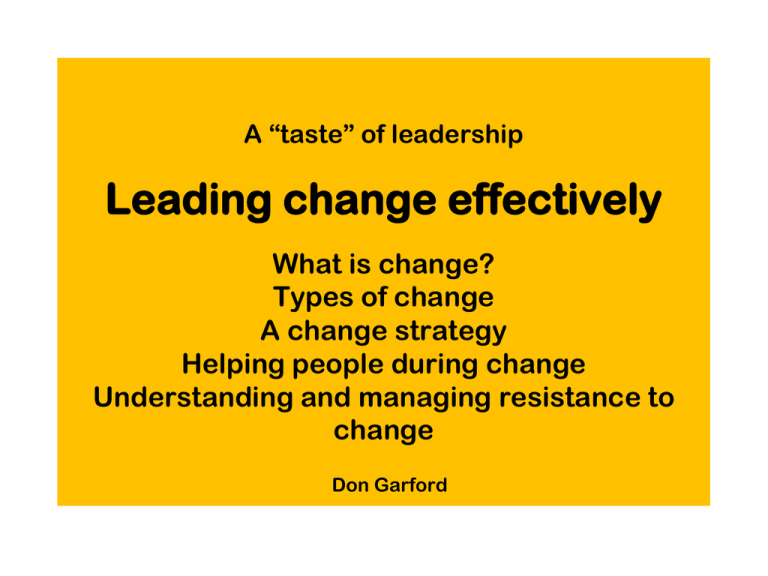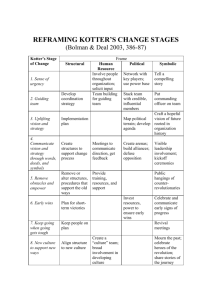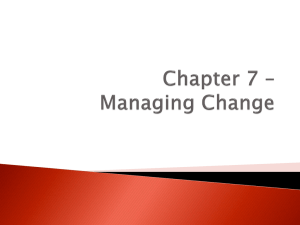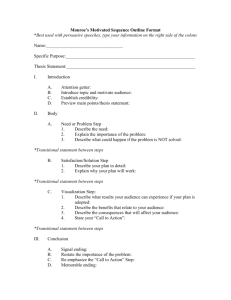The change - NHS Education for Scotland
advertisement

A “taste” of leadership Leading change effectively What is change? Types of change A change strategy Helping people during change Understanding and managing resistance to change Don Garford What is change? An alteration in the state or quality of anything Substitution or succession of one thing in place of another Types of change (Ackermann) Developmental Transitional Transformational Incremental change How change happened in the past in the NHS? Transitional change How change happens today in the NHS A change strategy Transitional Change (Kurt Lewin) Present Unfreezing Transition Moving Future Re-freezing Transitional Change Identifying where we are going? Present Autocratic Professional led Safety first Short term Opaque decisions Future Transition Empowering Patient led Allowable risk Long term Open decisions “Unfreezing” Methods Aim To unlock present patterns of behaviour Providing feedback from surveys and patients Vividly outlining the vision of the future Putting in place a “safety net” “Movement” Methods Aim To enable the journey to new behaviours Re-structuring of organisation Staff and management development Loads of communication “Re-freezing” Methods Aim Stabilising new behaviours to make them relatively secure against change Introduce reward systems that reward desired behaviour Develop feedback systems across the organisation Assessing the forces at play in a change “Force field analysis” Driving forces equilibrium Restraining forces Purposes of a force field analysis To identify who is involved in the change To map who will help or hinder the change To inform planning To inform the likelihood of success Force field analysis • Do a force field analysis for the following change Increasing the quantity and quality of collaborative working between pharmacy services and other professions • Identify 5 forces for each direction – wherever possible with individual named people Assessing the forces at play in the change Individual commitment Opposed Will oppose the change Neutral Will not oppose/will not actively support Support Will support if someone else takes the lead Lead Will lead The change “equation” …a quick risk assessment Dissatisfaction with the present Vision of the future The “cost” of the change Safe first step DxVxF>R Beckhard development of David Gleicher A change strategy - why change fails! (adapted from John Kotter) • • • • • • • • Allowing too much complacency Failing to create a sufficiently powerful coalition Underestimating the power of vision Under communicating the vision Permitting obstacles to block the new vision Failing to create short-term wins Declaring victory too soon Neglecting to anchor changes in the corporate culture Allowing too much complacency Establish a sense of urgency • Examine the market and competitive realities • Identify and discuss crises, potential crises, or major opportunities Failing to create a sufficiently powerful guiding coalition Create a strong guiding coalition • Put together a group with enough power and authority to lead the change • Getting the group to work together like a team Underestimating the power of vision Develop a vision and strategy • Creating a compelling and enticing vision. • Develop performance and people strategies for achieving that vision Under communicating the vision Communicate the vision… wherever…whenever • Plan to use every vehicle possible to constantly communicate the new vision • Having the guiding coalition role model the behaviour expected of employees Paired discussion For your recent change what evidence was there of a communication plan? Permitting obstacles to block the new vision Empower broad based action • Get rid of obstacles • Change systems or structures that undermine the change vision • Encouraging risk taking and nontraditional ideas, activities and actions Failing to create short-term wins Generate shortterm wins • Planning for visible improvements in performance, or “wins” • Visibly recognising and rewarding people who made the wins possible Declaring victory too soon Consolidate gains and preparing for more change • Use increased credibility to change systems, structures, and policies that don’t fit the transformation vision. • Hiring, promoting and developing people who can implement the change vision Neglecting to anchor changes firmly in the corporate culture Anchor new approaches in the culture • Continue to support customer or productivity orientated behaviour, • Maintain leadership and management development • Articulate the connection between new behaviours and organisational success Helping people during change The transition curve Managing resistance to change Why people resist change (Kotter and Schlesinger) • Parochial self interest • Misunderstanding and lack of trust • Different assessments • Low tolerance for change Handling resistance Education and communication Participation and involvement Facilitation and support Negotiation and agreement Manipulation and co-option What strategies are most evident in your organisation Explicit and implicit coercion How to lead change Summary •What is change? •Types of change •A change strategy •Helping people during change •Understanding and managing resistance to change Final reflections Reflect upon what we have covered in this workshop and draw one conclusion for you as a leader of change Leading change Some ending hints Have a strong and coherent vision The journey is turbulent Expect and plan for resistance New observations on your own change management?









